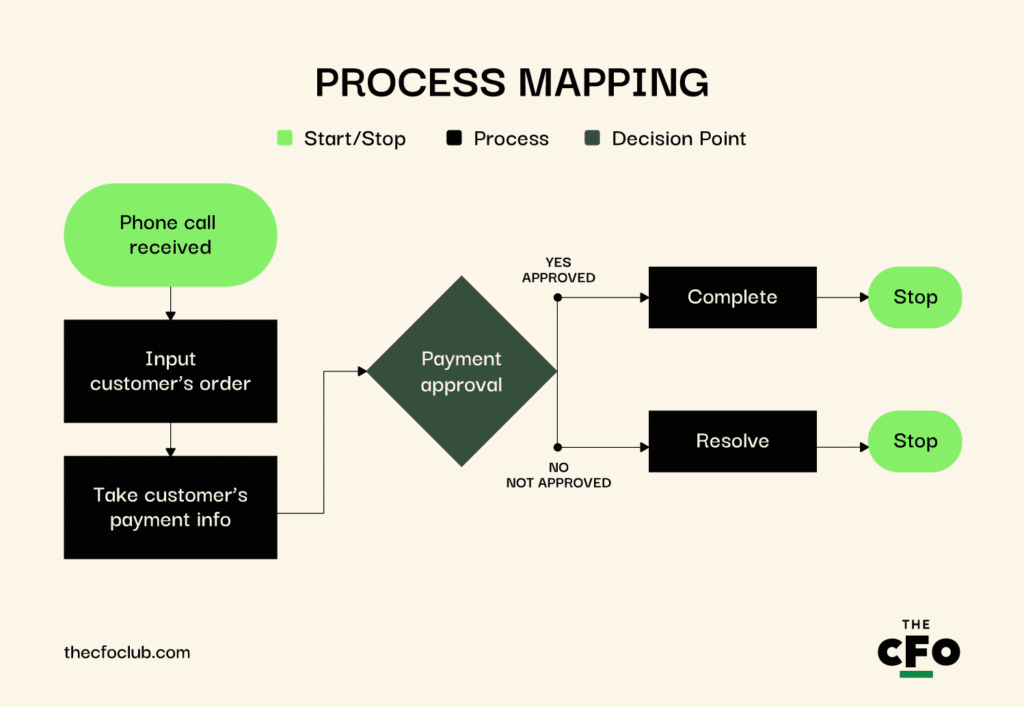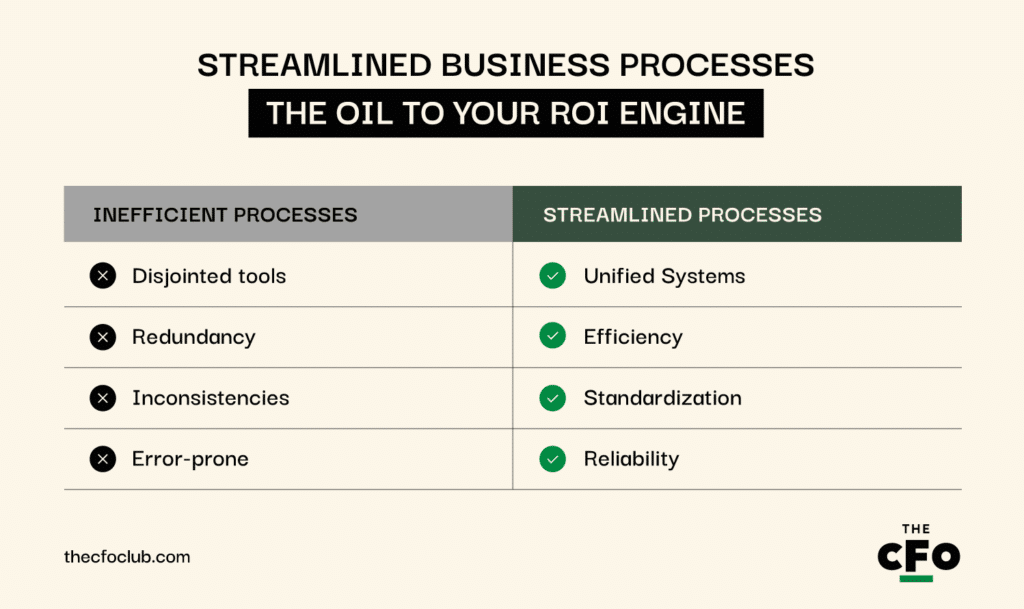Mundane Is My Nemesis: I think repetitive, mundane tasks (like sending templated emails) suck, so I procrastinate them heavily. News flash: your employees are just like me.
Streamlining Equals Sanity: Improving processes by eliminating repetitive tasks not only saves time but also maintains sanity and enhances productivity.
ROI Loves Streamlining: Improve your processes and you improve your ROI. Simple as that... right?
Step-by-Step to Success: Organize your business by identifying time-consuming tasks and using systems to streamline for immediate profitability improvements.
I struggle so much with tedious, repetitive work. Need to create a comprehensive business plan, with consultation from executives? No problem. Need 20 similar-but-distinct emails sent out? … I’ll get to it later.
I set out to prove the direct relationship between streamlined business processes and improved ROI, to give me some ground to stand on when I complain about how much inefficient processes are ruining my life.
Okay, fine, maybe it isn’t that dramatic… but it is going to help.
Here are the best ways to organize and improve your business processes, and the systems that’ll help you improve profitability immediately.
What Does Streamlining Business Processes Entail?
Streamlining your business processes is simple: identify and improve/eliminate repetitive, time-consuming, and unnecessary tasks.
When talking about business processes, specifically, streamlining means systematically evaluating workflows to uncover inefficiencies, block wastage, and boost overall ROI.
Benefits of Streamlining Business Processes
Your business success is tied to how streamlined your operations are. But, it's not exactly a straight line from efficient processes to more money. It’s more like a slightly zig-zagged line.
Here’s what I mean: Well-organized workflows produce key benefits like higher productivity, fewer errors, better planning, and more transparency. In turn, these benefits set the stage for increased profitability.
Increased Productivity
Streamlining improves productivity by eliminating unnecessary steps and tasks so you can redirect your efforts into more profitable activities. It also removes manual bottlenecks, helping you get more done in less time.
For example, if you find extensive approval tiers and documentation to be time-sinks at work, consolidating and automating these approvals will enhance your team’s productivity.
Reduced Errors
A key component of process streamlining is automation, which reduces manual workflows and speeds up execution — especially for repetitive tasks and steps.
Fewer manual steps = fewer opportunities for mistakes. This ensures record accuracy and reliability for decision-making.
Improved Transparency and Better Planning
Centralizing your organizational data in a single digital location is one of the ways to streamline your business processes, as it aids easy, real-time access to critical data. With accessibility, transparency, and visibility, you can create precise plans and quickly make data-driven decisions.
At the same time, streamlined processes make for better-defined roles and responsibilities, ensuring that there is always a specific individual accountable for tasks and desired outcomes. It also aids resource tracking and demand forecasting, preventing shortages, oversupplies, and other risks associated with poor planning.

Key Strategies For Streamlining Business Processes
Some of the common challenges in streamlining business processes include:
- Resistance to change
- Process complexity
- Technology limitations
- Cost considerations
Want to avoid these issues and get the most value from your process optimization activities? Use these strategies:
1. Study and Analyze Existing Processes
To identify processes that need streamlining, assess your current processes for inefficiencies or redundancies.
Start by documenting every step, task sequence, role, and responsibility for executing a specific activity. This documentation, known as process mapping, gives you a vivid picture of your current state of operations, uncovering areas for process improvement and refinement.

2. Automate Repetitive Tasks
Reduce manual work and optimize various processes by automating repetitive tasks. You can do this with ERP systems and business process automation (BPA) solutions, which leverage technology to reduce the need for human intervention in routine activities.
These options both offer automation tools for data collection, documentation, and project management, but I’m definitely partial to ERP. As you’ll see, most of the solutions I’ve come across are, frankly, just easier with this type of system.
3. Integrate Existing Platforms
Reduce operational silos and support seamless workflows in your organization with a well-thought-out platform integration strategy.
This process involves connecting your existing apps and platforms into one harmonized system, eliminating the need for manual checks and data transfers between standalone tools. Also, eliminating the expectation that helpful-but-forgetful Tom from accounting will “one day understand why I need this data.”
4. Use Low-Code/No-Code Solutions
Low-code or no-code development helps you streamline your business processes even with little to no IT expertise. No/low-code platforms allow you to design, build, and deploy software solutions with — you guessed it — minimal coding.
These platforms typically give you citizen development tools like pre-built templates, drag-and-drop builders, and reusable elements. That way, even if you’re a non-technical staff, you can streamline various business processes by creating and modifying apps:
- With minimal dependence on IT team members.
- Via collaborative development with other departments.
5. Monitor and Refine Processes
Process streamlining is not a one-off affair, it's an ongoing process that requires continuous monitoring. From tracking KPIs and metrics to aligning activities with predefined goals, understanding the effectiveness of your strategies will help you improve them as needed.
These adjustments could be anything from automating even more tasks to redesigning clunky/bloated procedures, reallocating scarce resources, and updating redundant policies. You can also boost the success of your workflow optimization efforts by setting up feedback loops to gather, analyze, and respond to stakeholder sentiments.
For example, the goal of a retail chain might be to streamline its checkout process and reduce wait times with self-checkout options—a process known as line busting. In this case, the implementation team needs to meticulously observe how their new checkout method performs, especially initially. Insights from this exercise can then be used to refine the new process.
Tools and Technologies for Streamlining
Most of the best streamlining strategies require tools and technologies for automation. Thankfully, there are tons of modern solutions that can give your business the efficiency and agility it needs.
Like I’ve said, though, I find ERP systems to be the best tool for automating most business processes, though process management tools, CRMs, and project management solutions also work.
Most workflow automation software systems are custom-built for specific use cases so, depending on your organizational needs, you might wind up using one or more.
Enterprise Resource Planning (ERP) Software
Best for: Improving resource utilization
ERP software offers numerous benefits, making it one of the most important tools for streamlining business processes.
First, ERP systems help you integrate and manage various functions and processes, enabling effective resource optimization. And second, since an ERP serves as a unified system for multiple business processes like project management, accounting, and compliance, it ensures that accessing organizational data is easy and quick.
With an ERP system, you’ll get instant insight, smart automation, and improved efficiency across the business. It’s no wonder ERPs of all types are seen as “the central nervous system of an enterprise”. Or, like I like to say, efficiency-driving powerhouses.
ERP software streamlines your business processes via:
- Integration: ERP systems connect various business functions, allowing a smooth flow of data and information across departments. This seamless integration leads to standardized, aligned, and coordinated workflows.
- Centralized data management: ERP tools eliminate data silos, ensuring all departments can access accurate and up-to-date information from a single source of truth.
- Automation: With an ERP platform, you can automate core business functions like human resources, finance, procurement, and supply chain management, consolidating data across departments.
- Standardized procedures: ERP software ensures data and process uniformity, reducing inconsistency and improving quality control.
- Resource planning and optimization: ERP software gives visibility into available resources and manpower, so you can plan better and limit wastage.
Before selecting an ERP, ensure your company is ERP-ready. Do this by completing an ERP readiness assessment, which evaluates your business’s current state to identify processes that need streamlining and changes to be made. Here’s what your readiness assessment should look at:
- The business’s challenges
- Whether an ERP system can address them
- Whether you’re ready to implement an ERP system and, if not, what you need to do to be
Beyond preparing you for successful implementation and use, this assessment will also equip you to choose the best ERP software for your business.
Ready For An ERP System?
These are the best tools on the market, as evaluated by my software review team and I.
Business Process Management (BPM) Software
Best for: Creating effective process workflows
Business process management refers to the different methodologies of analyzing, modeling, implementing, monitoring, automating, and optimizing business processes. BPM software helps you achieve these with minimal human intervention.
BPM software streamlines business processes and boosts efficiency through:
- Modeling: This exercise involves the visual presentation of workflows and processes to uncover inefficiencies and redundancies.
- Standardization: You can use BPM solutions to define clear, consistent procedures and rules, ensuring company-wide uniformity.
- Process automation: BPM platforms help you automate routine and repetitive tasks, ensuring they’re executed consistently and accurately.
- Gap analysis and workflow optimization: With BPM software, you can identify areas of improvement and remove productivity bottlenecks.
- Cost management: BPM tools with built-in expense reporting dashboards let you assess financial efficiency and maximize cost savings without exporting data to external apps.
Customer Relationship Management (CRM) Software
Best for: Interacting with prospects and customers
How does an all-in-one system for managing your prospect and customer relationships sound? That’s CRM software for you.
CRM solutions centralize your customer information and communication, helping you understand, manage, and relate with them better. These tools enhance sales and marketing results by boosting data accessibility and process efficiency,
CRM platforms streamline business processes through:
- Unified customer data: Having customer data in one accessible location saves time searching multiple systems and databases for information needed to personalize messaging.
- Automation: CRMs automate customer communication tasks, like lead outreach and technical support, reducing manual workload and minimizing errors.
- Strategic selling: From lead generation to conversions, CRM software systems support the entire sales process. They come with features that handle prospect data, score leads, automate follow-ups, and provide agent performance insights.
Project Management Software
Best for: Managing project scope, resources, and quality
Project management tools help you plan, organize, and manage projects. When you think of project management software, think of documentation, process mapping, task organization, scheduling, and budgeting.
A project management platform streamlines business processes through:
- Centralized planning: Project management software centralizes all project-related tasks, schedules, resources, and documents, giving team members unified access and clear execution guidelines.
- Task and workflow automation: A project management tool will save you time and energy on manually assigning tasks, sending status updates, and tracking deadlines.
- Resource management and allocation: With project management software, you’ll get clear visibility into workload and available resources for efficient allocation.
Case Studies and Examples
I remember calling an old professor of mine out for trying to teach marketing when they hadn’t actually done marketing for a business — if it’s purely academic, I don’t trust that it’ll work. Assuming you’re like me, I wanted to provide real-world examples.
Safety Management Group
Safety Management Group (SMG) is an environmental, health, and safety consultancy company that previously struggled with poor work processes, running on seven legacy systems that desperately needed consolidation.
Processes were manually intensive, error-prone and not sustainable in a growing business.
For example, the group’s CFO, Rebecca Ogle, struggled to get accurate time and expense data. HR leader, Tracy Kilburn, also had to regularly clock 40 to 50 hours a week just to enter payroll.
These challenges led SMG’s management to look for a process-streamlining solution aimed at reducing staff burnout, maximizing resources, and limiting errors. After a thorough assessment, the team opted for Acumatica, a cloud-based, mobile-compatible ERP system.
With Acumatica, SMG launched “Project 7 to 1”, merging all their seven legacy systems with minimal disruption and fantastic results:
- 10 hours saved weekly on payroll processes.
- $50,000+ saved by avoiding per-user licensing fees.
Milpark Education
A higher education provider with full-time, working professionals as students, Milpark Education, decided to shift from offering in-person classes to online learning.
However, to give online learners adequate support and flexibility, the organization communicated with students via emails, phone calls, and a ticketing system. These disconnected systems led to disjointed student interactions, siloed data, and poor visibility.
Incomplete student profile views caused long turnaround times and errors.
Which led the team to seek an integrated business solution. The goal? To gain greater visibility, save time, and optimize manpower — all of which impact competitiveness and profitability.
Milpark Education’s search led them to Microsoft Dynamics 365, a suite of ERP and CRM apps, which helped them achieve the following:
- Centralized and easily accessible student data.
- Reduced resolution times and escalation times by 50% and 30% respectively.
- Freed support staff up to focus on more complex cases.
Get Streamlining, Then Get Earning
Disjointed systems and complex processes drain resources — human, financial, or material — and reduce ROI.
But, streamlined workflows boost efficiency, cut costs, and facilitate massive bottom-line gains. Process streamlining also supports agility, empowering you to quickly adapt to changing market conditions and seize opportunities as they come.

Ready to compound your abilities as a finance professional and position your company for sustained growth and profitability? Subscribe to our free newsletter for expert advice, guides, and insights from finance leaders shaping the tech industry.
PS: if you want to share your own experience with business process optimization, send me a message on LinkedIn. Bonus points if you have hard data to validate the improvement.



